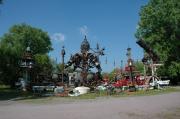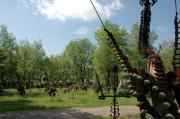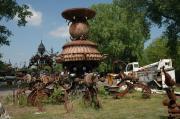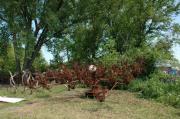Property Record
HIGHWAY 12
Architecture and History Inventory
| Historic Name: | Dr. Evermor's Sculpture Park |
|---|---|
| Other Name: | Forevertron |
| Contributing: | |
| Reference Number: | 87576 |
| Location (Address): | HIGHWAY 12 |
|---|---|
| County: | Sauk |
| City: | |
| Township/Village: | Sumpter |
| Unincorporated Community: | |
| Town: | 10 |
| Range: | 6 |
| Direction: | E |
| Section: | 10 |
| Quarter Section: | |
| Quarter/Quarter Section: |
| Year Built: | 1983 |
|---|---|
| Additions: | |
| Survey Date: | 1994 |
| Historic Use: | statue/sculpture |
| Architectural Style: | NA (unknown or not a building) |
| Structural System: | |
| Wall Material: | Metal |
| Architect: | Tom Every |
| Other Buildings On Site: | |
| Demolished?: | No |
| Demolished Date: |
| National/State Register Listing Name: | Not listed |
|---|---|
| National Register Listing Date: | |
| State Register Listing Date: |
| Additional Information: | A 'site file' exists for this property. It contains additional information such as correspondence, newspaper clippings, or historical information. It is a public record and may be viewed in person at the Wisconsin Historical Society, Division of Historic Preservation-Public History. Out of the remnants of destruction, artist Tom O. Every--"Dr. Evermor"--has created a playful yet provocative sculptural landscape. A fantastic world of giant birds, space-age vehicles, and other objects made from industrial cast-offs is set among the sidewalks and chimney ruins of an old schoolyard. The area was once part of Badger Village, a housing complex built during World War II for employees of the nearby ordnance works. Amid these ruins, using artifacts that reflect the ingenuity and rapid obsolescence of America’s industrial technology, Every has assembled a monumental work of folk art that reclaims and re-forms history. During the 1960s, Every's work in industrial salvage brought to his attention artifacts that held, for him, exceptional aesthetic and historic value. Collecting and reconstructing these objects into larger sculptures, he retained their existing shapes and forms and preserved their original craftsmanship, ingenuity, and energy, while also giving them new and personal meanings. Every's earliest and most massive piece is "The Forevertron," formerly known as "The Force," a mythical vehicle that, according to Every, transports a person to a higher plane through the harnessing of lightning. From a distance, "The Forevertron" resembles a futuristic Victorian amusement-park ride. Closer inspection reveals a collage of historic discarded objects assembled into a vehicle that figuratively enables a person to traverse time and space. The sculpture is over 40 feet tall and 120 feet long, and it reportedly weighs more than 250 tons. Its hundreds of historic objects include the decontamination chamber from the Apollo space program, a double compound steam engine, and several bipolar dynamos manufactured by Thomas Edison and acquired from the Henry Ford Museum. Numerous other sculptures followed "The Forevertron," each constructed of industrial objects: a 1920s gas tank forms the body of an 18-foot-tall spider, an "orange peel" pile-digger composes an enormous eagle's head, and antique motors form the bodies of three elegantly plumed birds, each over 15 feet tall. Some of the sculptures lurk along the roadway. But to get to the heart of the sculpture park, visitors must venture through Delaney's Surplus salvage yard, where contemporary scrap gradually yields to an imaginative landscape literally made of history. |
|---|---|
| Bibliographic References: | Buildings of Wisconsin manuscript. |
| Wisconsin Architecture and History Inventory, State Historic Preservation Office, Wisconsin Historical Society, Madison, Wisconsin |





